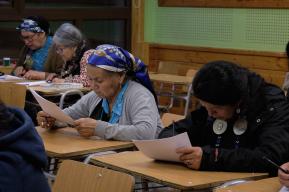The Natural and Cultural Heritage of the Ohrid region has been inscribed on the UNESCO World Heritage List since 1979 as a natural site and since 1980 as a mixed site, including the cultural and historical area. In 2019, the World Heritage property was extended from its original area in North Macedonia to the territory of Albania as a transboundary site. In 2014, the region was included in the Ohrid-Prespa Transboundary Biosphere Reserve, a cross-border area with rich cultural, ethnic and religious diversity. In recent years, as tourist numbers have steadily risen, new anthropogenic pressures are being placed on the biosphere reserve, particularly on the St. Naum springs. During high season, Ohrid’s population increases dramatically, as do risks of water pollution and waste.
The site is an area of outstanding natural beauty and provides refuge for numerous freshwater species of flora and fauna. Accurate data on the region is currently limited, however, presenting a challenge for future conservation efforts. To remedy this, the Public Institution Galicica National Park has developed an innovative way of mapping water-related ecosystems through the “St. Naum springs – Biological and Ecosystem services Inventory (SN-BESI)” project, as one of the 5 sites selected for the first cycle of the project “Promoting sustainable development through UNESCO’s programmes and sites”.
As part of the project’s first phase, the managing authority launched two sampling campaigns in 2022 to reflect the current state of ecosystem function and biodiversity, monitoring the flora and fauna of the springs. Assessed against the criteria of the European Water Framework Directive, this data revealed that St. Naum springs’ water is of a significantly lower quality than is expected from freshwater springs.
The sustainable management of the springs is of pivotal importance to maintain the region’s natural beauty and its cultural and religious heritage alongside a successful tourism industry. As such, the Public Institution Galicica National Park is keen to work alongside stakeholders in its conservation efforts and to collaborate on the region’s future management. A series of events were held to educate the population on the potentially damaging effects of human activity in the biosphere reserve. Students and teachers alike participated in a series of environmental education workshops in February and March, and a workshop for local stakeholders took place towards the end of March. The Public Institution has also developed 3 Environmental Education (EE) packages which call attention to the St. Naum springs’ natural and cultural values, endemism in the region and its ecosystem services.
Already, local populations have become more aware of the ecological issues that affect their surroundings and how they impact their health and well-being. Biological monitoring and environmental education have helped individuals and communities understand their role in preserving and protecting natural resources and ecosystems, such as forests and waterways, and it is hoped that, as a result, local populations will be more motivated to volunteer for clean-up events or advocate for policies that promote sustainability.

I have witnessed the positive impact of environmental education on my students. My school has been actively promoting environmental awareness and sustainability for many years, and I have seen tremendous growth in my students’ understanding and appreciation for the natural world.
Loshkoska credits “Angela Taseska from the National Park Galicica for always organising some kind of event that makes my job easier and makes the learning experience more interesting for my students.” The educational games organised by the National Park staff have been warmly received by students as well as teachers. Konstain Trajanoski, a pupil at Grigor Prlicev Primary School said that “the people from the National Park are always organising different events that I attend. This makes me think creatively about how I can make a positive impact on the environment. I am grateful for the environmental education I have received, and I believe that it will shape the way I approach environmental issues for the rest of my life.”
The Public Institution Galicica National Park is leading the way on environmentally responsible policies, creating a Site Management Plan using the data obtained from their field work, as well as from public hearings and individual meetings with stakeholders. This participatory approach will ensure that future guidelines and rules will be developed with the community’s input, encouraging grassroots level sustainable management going forward.
As part of the UNESCO and the abrdn Charitable Foundation (aCF) 3-year partnership launched in 2022, the project “Promoting sustainable development through UNESCO’s programmes and sites” seeks to promote a more sustainable and climate neutral Europe by working with Biosphere Reserves and other UNESCO sites to act as pilot sites for sustainable development.











